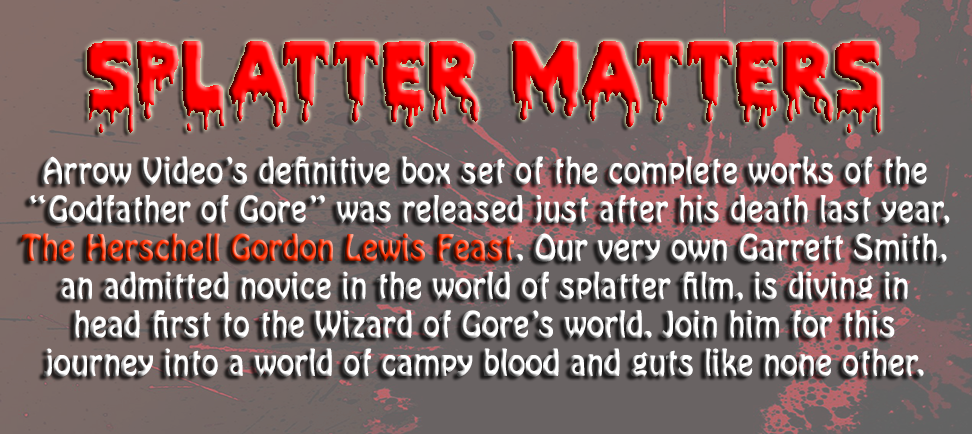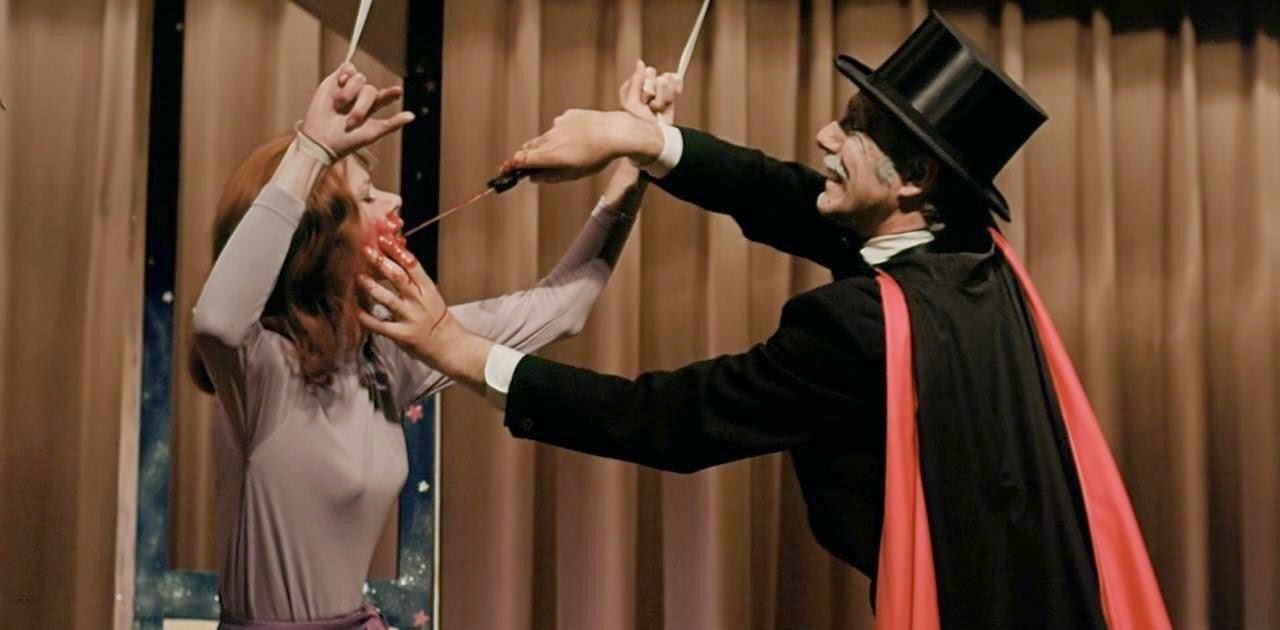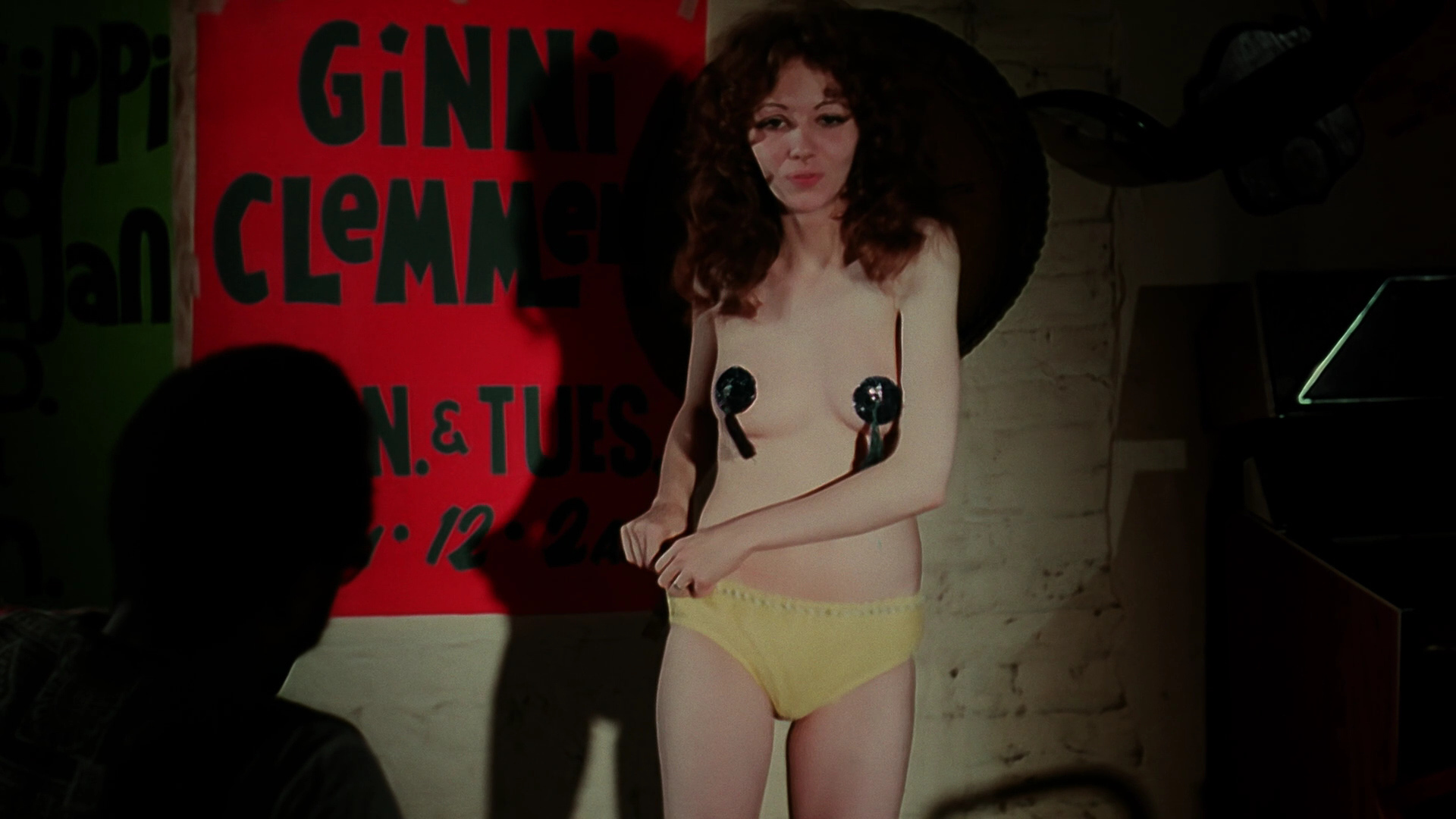Splatter Matters: The Final Disc and the Final Verdict

Previously on Splatter Matters:
With The Wizard of Gore, Herschell finally seemed to come into his own as The Godfather of Gore that he’s now known as. When I began this journey through his career, I had incorrectly thought that all of his movies would be the slap-stick splatter-fest that The Wizard of Gore is. It would instead turn out that he was a bit of a journeyman who needed to find his footing in both splatter and comedy before he’d synthesize the two, and even longer before he’d figure out the perfect blend of the two. But now that he has, what does he do next?

In This Stuff’ll Kill Ya!, Herschell returns to his early days of what he calls “southern pictures” but this time with his foot firmly on the comedy gas peddle. Jeffrey Allen, regular HGL player that features in almost all of his southern pictures, stars as Reverend Roscoe Boone who runs a distillery out of what he’s named the “Congregation Of The Heavenly Spirits.” He’s essentially a con-man that has either convinced a whole town he’s a preacher or poisoned their brains with enough moonshine that they don’t care one way or the other. There are some ideas in this that I do kind of enjoy, like the way Boone uses bible verses to back up whatever position he has decided to take in any given moment and has created rituals around drinking his moonshine that result in his congregation paying him a little money for each sip, as if it’s a tithe. I have to imagine this is a sneering condemnation of organized religion as a whole, which I am firmly on board with myself, especially since he’s specifically paralleling Christianity with a big con. There are, however, also some ideas along the exact same lines that make me furious with Herschell for thinking they are also a clever joke – like when Boone offers up the daughter of one of his own business partners, right in front of him and on her wedding day, to be gang raped by the entire town and claims this is a biblical wedding ritual per the scripture.
It’s difficult for me to wrestle with the sexual violence perpetrated against women throughout HGL’s career (mostly because he always treats it as a joke), but honestly this movie’s biggest sin is ultimately that it’s just pretty plain and boring. This may be due to the fact that nearly all of the dialogue in the movie is complete and utter nonsense, some of it not even intelligible, which we can perhaps count as a “choice” and Herschell’s attempt to accurately depict a town that’s collectively on a moonshine bender, but that might be giving him too much credit. The most exciting event in the film is when a man going blind from moonshine has to drive a few cases of shine across county lines, loses control and drives into a lake, the impact of which… makes his car explode into a million pieces? But somehow the presumably extremely flammable moonshine survives? It’s really funny, and per usual I have no idea how intentional this particular bit of comedy is.

And just to make sure this detail gets included, as it’s important to our ultimate findings here regarding splatter and its use in film, the movie does conclude with an epic moment of splattery delight. It’s mostly devoid of horror and gore throughout, though there are a few brief occurrences of women being murdered to establish a sort of mystery within the film (this is not to downplay their deaths myself – the movie sort of breezes through these moments and they’re far less graphic than you’d expect from HGL). But in quite literally the final seconds of the movie, as the government forces Boone and his cronies to shut down their moonshine operation, Ray Sager, the Wizard of Gore himself, accidentally blows his own head off with a shotgun in spectacular fashion, and then the credits immediately roll. It’s as if Herschell completely forgot why we watch his movies and only remembered at the last second, and that’s kind of hilarious in and of itself.
With This Stuff’ll Kill Ya! acting as a sort of reminder of where HGL came from, The Gore Gore Girls stands out as a primo example of how far he’s come as a film maker. At the time of its production, Herschell thought The Gore Gore Girls would be his last movie (which would remain true for 30 years before he returned with Blood Feast 2: All U Can Eat in 2002), and so he decided to “go out in a blaze of bloody humor,” and “put more production value into [it] than [he] had ever allocated for a previous film,” as he says in his intro. And it truly shows; The Gore Gore Girls looks far better than any other film in this set. The sets and costumes are better, the lighting and framing is greatly improved, and even the gore FX are more believable and gruesome. While The Wizard of Gore may be his most recognizable film, The Gore Gore Girls is HGL at the height of his talents. You can even feel him behind the camera more; this isn’t as anonymously directed as his previous efforts and has some legitimately stylized moments that are genuinely memorable. It’s not my favorite of his movies (why has no one remade Color Me Blood Red yet!? Wait, don’t do it – I want to make it) but it is without question his most accomplished movie that I’ve seen.
Not that plot is much of a concern when it comes to our good friend Herschell, but for your benefit, dear reader: The Gore Gore Girls is about Abraham Gentry (Frank Kress), a renowned private eye in Chicago who is hired by Nancy Weston (Amy Farrell), a local reporter, to help catch a serial killer who is targeting strippers from various local clubs. This premise allows for two of Herschell’s favorite things to put on film – boobs and blood, and lots and lots of both. Even for HGL this movie has an excessive amount of female nudity, and unfortunately that means more of his “jokey” sexual violence as well (I refuse to describe what happens to one woman’s nipples in this movie – this implication is plenty gross enough and I’m only including it so wary viewers are warned). This is far and away his most brutal and graphic movie, with Herschell letting shots of smashed skulls and butts mashed with meat tenderizers (yes, you’re reading that right) linger for a legitimately ridiculous amount of time. And quite honestly, it ends up being a lot of fun despite my reservations about his insistence on making some of his violence sexual. There are some truly inspired death scenes, like one where a women is blowing a bubble with bubble gum as she’s murdered, which causes the bubble to fill up with blood. And these are often underscored by what can only be described as county fair music, a stroke of brilliant nonsense that only Herschell would include in a movie.
It’s worth noting that HGL mines some legitimately decent comedy out of this concept as well. Kress portrays Gentry as a Sherlock-like genius of deductive reasoning and a sort of slimy, seemingly asexual predator. He spends nearly the entire movie being completely disinterested in Ms. Weston’s advances, often to comedic effect, and to the point that you legitimately believe he has no interest in her. But of course, his long con is that he’s perfectly aware that his disinterest is a version of negging, and he uses this to his “strategic advantage” in the finale when Weston decides that she herself must strip, thus becoming bait for the killer. This leads to the funniest death scene in any HGL movie when the killer is revealed, immediately falls out of a window, lands on the street below, and at that very instant a car passes by, completely obliterating the killer’s head in grand splattery fashion, to which Gentry exclaims “Ah, what a character,” in his completely disinterested, smarter-than-thou tone. And then he of course finally has sex with Weston, because he is indeed a predator of his own kind. Whatever you think of the sexual politics at play (and I’d call them lousy at best) this is truly a splatter movie in what we would now call the traditional sense – a nice blending of comedy and gore that makes for a pretty entertaining time at the movies, as long as you can stomach it.

And so, here at the ultimate conclusion of Splatter Matters, we have two movies: one that is unbearably boring and nearly devoid of splatter, and one that may be the pinnacle of Herschell’s work as a film maker and could reasonably be described as one of the progenitors of this genre in America. In fact, The Gore Gore Girls is the first time I can recall in his career that Herschell truly tips his hat to the Giallo film makers that likely influenced his work by having his killer only be seen as a pair of black-gloved hands until the very end. But what does that tell us about the value of splatter? Does it in fact matter?
Undoubtedly yes, it matters a great deal. In a specific sense, were it not for the exploding head at the end of This Stuff’ll Kill Ya!, there would be no reason to recommend that movie to you (beyond hearing Jeffrey Allen deliver the line “That little gal’s got a mouth like an oven full of hot snakes!”). And The Gore Gore Girls ends up being one of Herschell’s most watchable and entertaining movies by leaning into the genre more than he had ever had before. But in a larger sense, in the greater context of film history, HGL serves as a link between the Italian horror movies that are beloved among horror fans and the great American splatter films like Sam Raimi’s Evil Dead series. It seems clear to me that movies like Blood Feast, Two Thousand Maniacs!, Color Me Blood Red, and The Wizard of Gore had a massive impact on American cinema and culture, creating a space for gore and yes, sleaze, in American horror movies, thus helping to open the doors for film makers like Stuart Gordon, Lloyd Kaufman, and the aforementioned Raimi, among others. Splatter Matters in that it allows young film makers to experiment in the medium at a relatively low cost and risk while they hone in on their voice as creators, and that is a necessary and wonderful space that Herschell helped to create.
Also, splatter is often just plain fun – and while I’ve been at odds with Herschell and what may be his worldview over the course of this series, it seems clear to me that fun is what was in his heart. He just wanted to have fun and provide me with some fun in the process. Moral quandaries aside, I absolutely had a blast watching his movies, the worst of which are still fun to describe and talk about with people, and that’s really what I love most about movies. As Leonard Maltin likes to say, “The only thing better than watching movies is talking about movies,” and Splatter provides an endless font of insanity from which to draw conversation.
RIP HGL – attention is paid.




